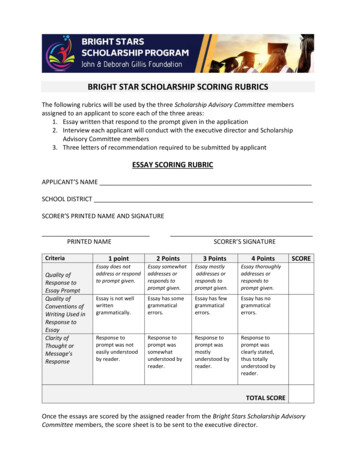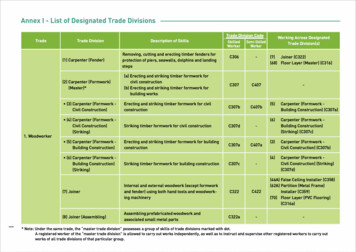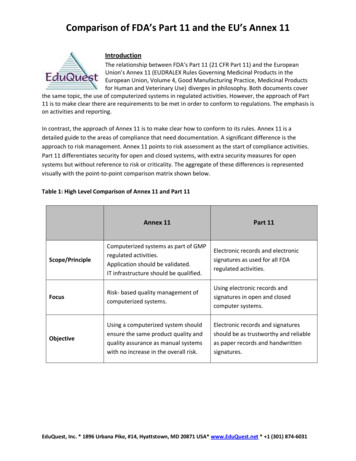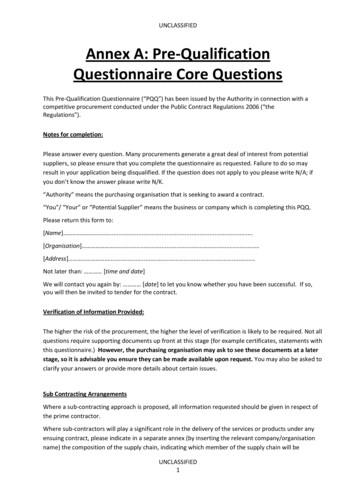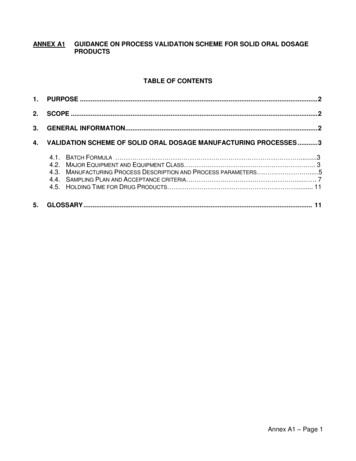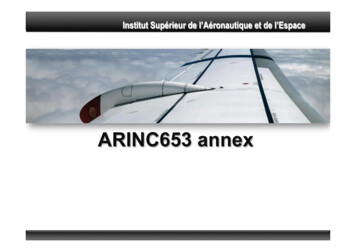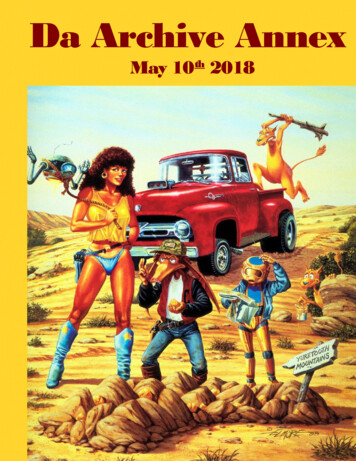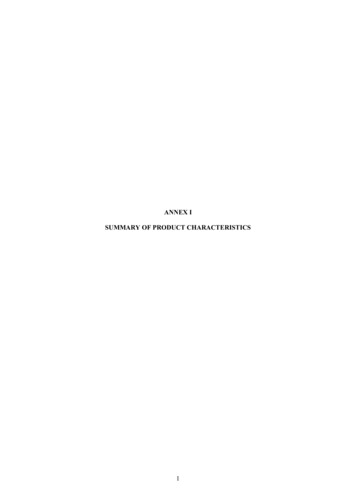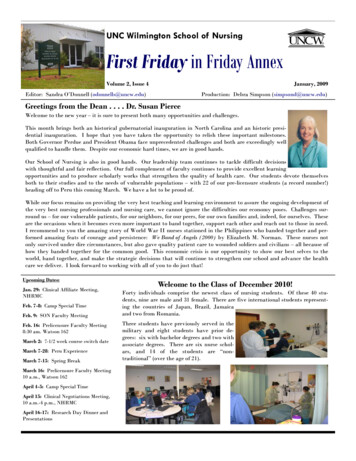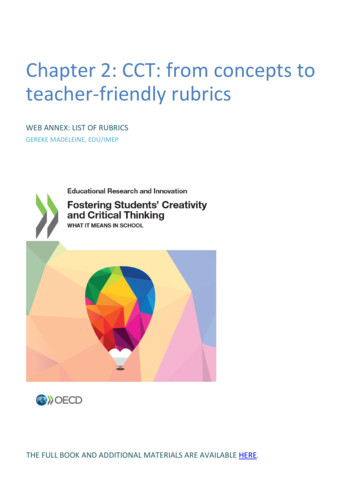
Transcription
Chapter 2: CCT: from concepts toteacher-friendly rubricsWEB ANNEX: LIST OF RUBRICSGEREKE MADELEINE, EDU/IMEPTHE FULL BOOK AND ADDITIONAL MATERIALS ARE AVAILABLE HERE.
Table of Contents1.Australia Curriculum . 3Australia Curriculum - Description . 42.Galileo Education Network . 9Galileo Education Network - Description. 103.Achievement Charts . 11Achievement Charts - Description . 124.Quebec Curriculum . 13Quebec Curriculum - Description. 145.Chile: Educar Chile . 15Chile: Educar Chile - Description . 166.Creative Little Scientist . 17Creative Little Scientist – Description . 187.India: Central Board of Secondary Education’s Continuous and Comprehensive Evaluation . 19India: Central Board of Secondary Education’s Continuous and Comprehensive Evaluation - Description . 208.Design for Change (India) . 21Design for Change (India) - Description . 229.Israel - Assessment Tool of Creativity and Critical Thinking . 23Israel - Assessment Tool of Creativity and Critical Thinking – Description . 2410.Japan- Human-Centered Innovation . 25Japan- Human-Centered Innovation - Description . 2611.Netherlands – The Draft Report by SLO . 27Netherlands – The Draft Report by SLO – Description . 2812.Quick Scan Creativity. 29Quick Scan Creativity – Description . 3013.Puerto Rico- Critical Thinking Rubric, University of Puerto Rico Rio Piedras. 31Puerto Rico- Critical Thinking Rubric, University of Puerto Rico Rio Piedras - Description . 3214.Scotland Curriculum for Excellence . 33Scotland Curriculum for Excellence – Description . 3415.Spain: Innovation and Creativity Evaluation Template, Universidad de Europa Madrid . 35Spain: Innovation and Creativity Evaluation Template, Universidad de Europa Madrid - Description . 3616.Spain: LA BATERÍA PIC (Test of Creative Imagination) . 37Spain: LA BATERÍA PIC (Test of Creative Imagination) – Description. 3817.United Kingdom: progression in student creativity in school: first steps towards new forms of formativeassessments (Lucas Et Al). 391
United Kingdom: progression in student creativity in school: first steps towards new forms of formativeassessments (lucas et al) - description. 4018.US- Buck Institute for Education . 41US- Buck Institute for Education – Description. 4219.Culture of Creativity . 43Culture of Creativity – Description. 4420.Dschool. 45Dschool – Description . 4621.United States-Holistic Critical Thinking Scoring Rubric . 47United States-Holistic Critical Thinking Scoring Rubric – Description . 4822.Partnership for 21st Century Skills . 49Partnership for 21st Century Schools – Description . 5023.Value Rubric . 51Value Rubrics - Description . 5224.US-Illinois Curriculum . 53US-Illinois Curriculum – Description . 5425.USA- Critical and Integrative Thinking Rubric, Washington State University . 55USA- Critical and Integrative Thinking Rubric, Washington State University - Description. 5626.International Baccalaureate Program . 57International Baccalaureate – Description . 582
1. Australia CurriculumGeneral informationCountry:Authors:AustraliaEducation Services ve-thinkingStatus of the framework:Definition of object to assessPart of the Australian curriculumSkill name:Critical and creative thinkingPart of a larger framework:1 of 7 general capabilities:Literacy- Numeracy- Ethical understanding1 constructRelation between critical thinking and creativity:-ICT capabilityPersonal and social capabilityIntercultural understandingDefinition of progression:Progress is defined as ‘Typically by the end of year X, students ’, includingconcrete examples. Students are expected to progress one level each twoyears, starting from pre-primary (age 5/6) to upper secondary level (age15/16).Units of analysis:72 units (4 domains x 3 sub-domains x 6 levels), see below for details4 domains1. Inquiring – identifying,exploring, organisinginformation and ideas3 sub-domains1.1 Pose questions1.2 Identify and clarifyinformation and ideas1.3 Organise and processinformation2. Generating ideas,possibilities and actions2.1 Consider alternatives2.2 Imagine possibilities andconnect ideas2.3 Seek solutions and put ideasinto action3. Reflecting on thinking,actions and processes3.1 Think about thinking3.2 Reflect on processes3.3 Transfer knowledge into newcontexts4. Analysing, sythesisignand evaluating reasoningand procedures4.1 Apply logic and reasoning4.2 Draw conclusions and designa course of action4.3 Evaluate procedures andoutcomesType of assessmentApproach:6 levels of progressionSee below for details2.2.1 Use imagination to view or create things in new ways and connect twothings that seem different; e.g Changing the shape or colour of familiarobjects2.2.2 Build on what they know to create ideas and possibilities in ways thatare new to them; e.g using a flow chart when plotting actions\2.2.3 Expand on known ideas to create new and imaginative combinations;e.g exchanging or combining ideas using mind maps2.2.4 Combine ideas in a variety of ways and from a range of sources to createnew possibilities2.2.5. Draw parallels between known and new ideas to create new ways ofachieving goals2.2.6 Create and connect complex ideas using imagery, analogies andsymbolism, e.g. formulate hypotheses based on known models.Generic, with links to develop these skills in specific curriculum subjects(particularly, English, Mathematics, Science and History)Set of activities/particular tasks related:Not explicitly statedAssessor:Teacher assessmentApplicable to education level(s):Primary and secondary levelSpecific pedagogical background required:NoGrade and age-range:Pre-primary (age 5/6) to upper secondary level (age 15/ 16) standardisedOECD definitions3
Australia Curriculum - DescriptionIn the Australian Curriculum “Critical and creative thinking” is 1 of 7 general capabilities. The other 6capabilities include: Literacy; Numeracy; ICT capability; Personal and social capability; Ethical understanding;and, Intercultural understanding. Within the Australian Curriculum framework, critical and creative thinking areconsidered to be part of the same construct. This construct distinguishes between 4 different domains, with each3 sub-domains and 6 levels of progress.As a framework for creativity and critical thinking it is quite comprehensive and detailed compared to otherexisting frameworks. This is largely due to the level of detail in the definition of progress. Levels are describedin terms of ‘Typically by the end of year X, students .’, indicating assessment of progress across a wholeschool career. Students are considered to progress one level each two years of school, which makes that level 1corresponds with Foundation Year (age 5-6), level 2 with Year 2 (age 7-8), level 3 with Year 4 (age 9-10), level4 with Year 6 (age 11-12), level 5 with Year 8 (age 12-14) and level 6 with Year 10 (age 15-16). Each level alsoincludes a concrete example of what students ought to be able to do after that reaching a particular level, e.g.‘Developing hypotheses based on known and invented models and theories’ as an example of having reachedlevel 6 of the sub-domain ‘Imagining possibilities and connect ideas’.The Australian Curriculum framework does not include socio-emotional/behavioural skills and has a genericapproach to assessing creativity and critical thinking. Despite its generic approach, it does however providelinks to opportunities to develop these skills in specific curriculum subjects (particularly English, Mathematics,Science and History).4
1.1.1 pose factual and exploratory questions based on personal interests and experiences(asking why events make people happy or sad)1.1.2 pose questions to identify and clarify issues, and compare information in their world(asking how and why certain actions and events occurred)1.1.3 pose questions to expand their knowledge about the world(asking who, when, how and why about a range of situations and events)1.1.4 pose questions to clarify and interpret information and probe for causes and consequences(inquiring into cause and effect of significant events in their lives)1.1.5 pose questions to probe assumptions and investigate complex issues(questioning causes and effects of local and world events)1.1.6 pose questions to critically analyse complex issues and abstract ideas(questioning to uncover assumptions and inferences and provoke debate about global events)1. Inquiring –identifying, exploring,organising informationand ideas1.1 Pose questions1.2 Identify and clarify information and ideas1.3 Organise and process information1.2.1 identify and describe familiar information and ideas during a discussion or investigation(identifying what led to a decision being made)1.2.2 identify and explore information and ideas from source materials (exploring patterns and similarities)1.2.3 identify main ideas and select and clarify information from a range of sources(establishing a sequence during investigation of artefact, image or text)1.2.4 identify and clarify relevant information and prioritise ideas(giving reasons for a preferred pathway when problem solving)1.2.5 clarify information and ideas from texts or images when exploring challenging issues(identifying the strengths and weaknesses of different approaches)1.2.6 clarify complex information and ideas drawn from a range of sources(scrutinising contrasting positions offered about events or findings)1.3.1gather similar information or depictions from given sources(collecting a variety of representations of particular action(s))1.3.2 organise information based on similar or relevant ideas from several sources(finding examples of kindness or change in several sources)1.3.3 collect, compare and categorise facts and opinions found in a widening range of sources(processing relevant depictions of an event)1.3.4 analyse, condense and combine relevant information from multiple sources(establishing opinion versus fact in literature and film)1.3.5 critically analyse information and evidence according to criteria such as validity and relevance(scrutinising the accuracy of depicted events)1.3.6 critically analyse independently sourced information to determine bias and reliability(critiquing data from known and unknown sources)5
2.1.1 use imagination to view or create things in new ways and connect two things that seem different(changing the shape or colour of familiar objects)2.1.2 build on what they know to create ideas and possibilities in ways that are new to them(using a flow chart when plotting actions)2.1.3 expand on known ideas to create new and imaginative combinations(exchanging or combining ideas using mind maps)2.1.4 combine ideas in a variety of ways and from a range of sources to create new possibilities(by matching ideas from science and history)2.1.5 draw parallels between known and new ideas to create new ways of achieving goals(using patterns and trends in Mathematics to arrive at possible solutions in other learning areas)2.1.6 create and connect complex ideas using imagery, analogies and symbolism(developing hypotheses based on known and invented models and theories)2.1 Imagine possibilities and connect ideas2. Generating ideas,possibilities and actions2.2 Consider alternatives2.3 Seek solutions and put ideas into action2.2.1 suggest alternative and creative ways to approach a given situation or task(considering alternative uses for a familiar product)2.2.2 identify and compare creative ideas to think broadly about a given situation or problem(considering ways of conserving water in their environment)2.2.3 explore situations using creative thinking strategies to propose a range of alternatives(asking ‘What if.?’ when conducting an investigation)2.2.4 identify situations where current approaches do not work, challenge existing ideas and generate alternative solutions(examining the environmental impact of transporting goods)2.2.5 generate alternatives and innovative solutions, and adapt ideas, including when information is limited or conflicting(negotiating a solution to a community dispute)2.2.6 speculate on creative options to modify ideas when circumstances change(submitting designed and developed ideas or products for further investigation)2.3.1 predict what might happen in a given situation and when putting ideas into action(suggesting different endings to a story)2.3.2 investigate options and predict possible outcomes when putting ideas into action(exploring identified problems and ways of overcoming them)2.3.3 experiment with a range of options when seeking solutions and putting ideas into action(using a graphic organiser to suggest alternative solutions)2.3.4 assess and test options to identify the most effective solution and to put ideas into action(using role plays to test and refine approaches when initial ideas do not work)2.3.5 predict possibilities, and identify and test consequences when seeking solutions and putting ideas into action(using information from a range of sources to predict results from an inquiry or investigation)2.3.6 assess risks and explain contingencies, taking account of a range of perspectives, when seeking solutions and puttingcomplex ideas into action (expressing difficult concepts digitally, kinaesthetically or spatially)6
3.1.1 describe what they are thinking and give reasons why(drawing on a past experience to explain their thinking)3.1.2 describe the thinking strategies used in given situations and tasks(describing how they approach tasks when they are not sure what to do)3.1.3 reflect on, explain and check the processes used to come to conclusions(explaining ways they check their thinking and deal with setbacks)3.1.4 reflect on assumptions made, consider reasonable criticism and adjust their thinking if necessary(identifying where methods of investigation and inquiry could be improved)3.1.5 assess assumptions in their thinking and invite alternative opinions(reflecting on the accuracy of their own and others’ thinking)3.1.6 give reasons to support their thinking, and address opposing viewpoints and possible weaknesses in their own positions(reflecting on justifications for approaching problems in certain ways)3.1 Think about thinking (metacognition)3. Reflecting on thinking,actions and processes3.2 Reflect on processes3.3 Transfer knowledge into new contexts3.2.1 identify the main elements of the steps in a thinking process (identifying steps involved in daily routines)3.2.
Chapter 2: CCT: from concepts to teacher-friendly rubrics WEB ANNEX: LIST OF RUBRICS GEREKE MADELEINE, EDU/IMEP T
